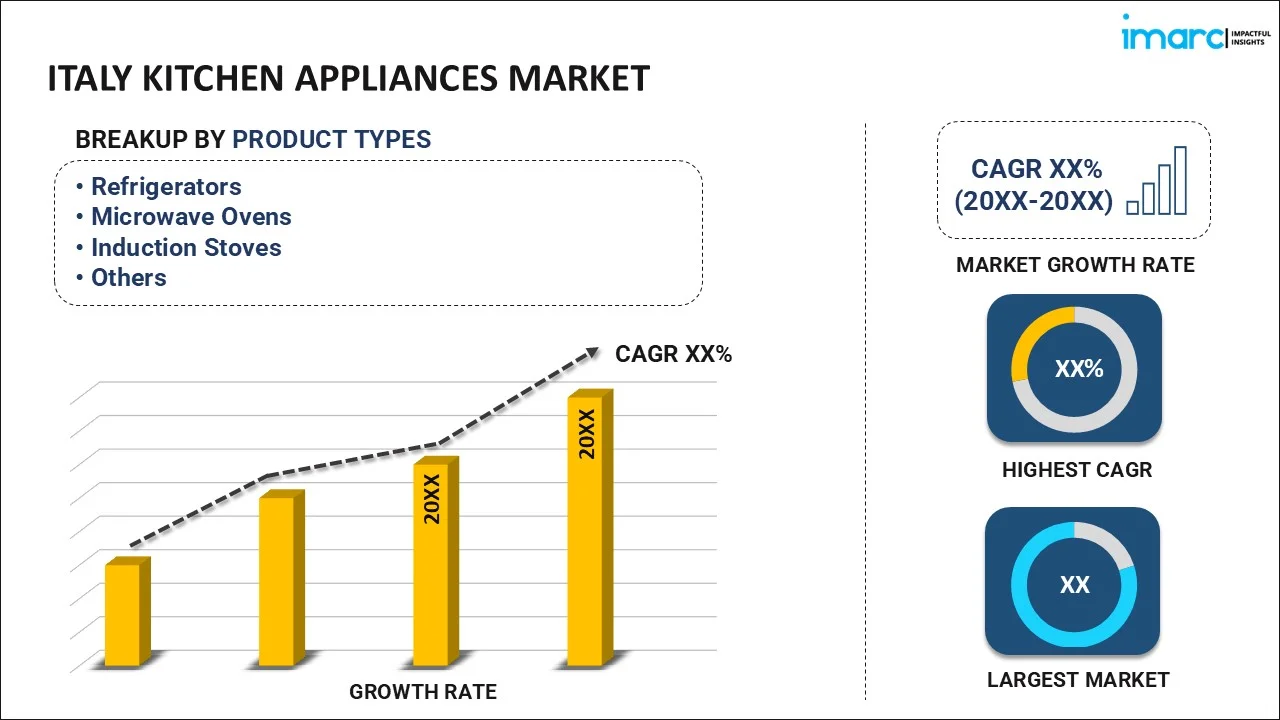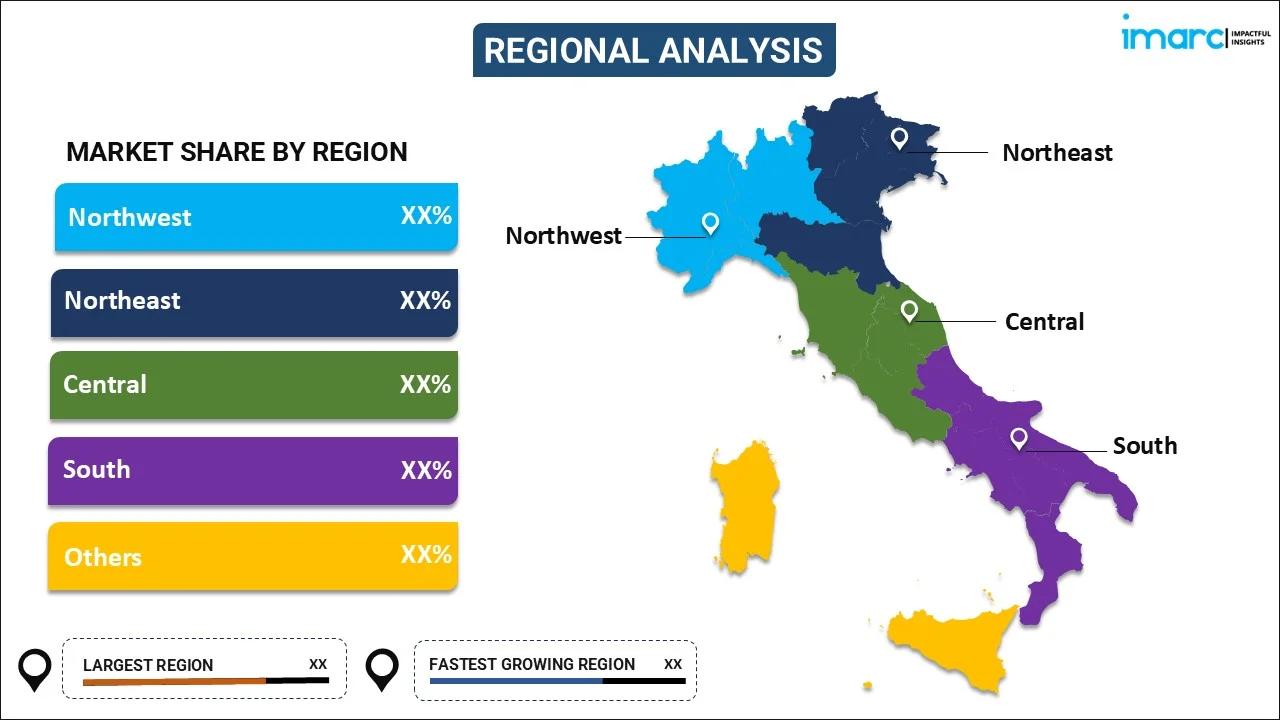
Italy Kitchen Appliances Market Size, Share, Trends and Forecast by Product Type, Structure, Fuel Type, Application, Distribution Channel, and Region, 2025-2033
Italy Kitchen Appliances Market Overview:
The Italy kitchen appliances market size reached USD 5.35 Billion in 2024. Looking forward, IMARC Group expects the market to reach USD 7.95 Billion by 2033, exhibiting a growth rate (CAGR) of 4.18% during 2025-2033. Rising demand for smart and energy-efficient appliances, increasing urbanization, growing disposable incomes, expansion of modular kitchens, technological advancements, e-commerce popularity, and government incentives for energy-saving appliances are driving the growth of the Italy kitchen appliances market.
|
Report Attribute
|
Key Statistics
|
|---|---|
|
Base Year
|
2024
|
|
Forecast Years
|
2025-2033
|
|
Historical Years
|
2019-2024
|
| Market Size in 2024 | USD 5.35 Billion |
| Market Forecast in 2033 | USD 7.95 Billion |
| Market Growth Rate (2025-2033) | 4.18% |
Italy Kitchen Appliances Market Trends:
Rising Demand for Smart and Connected Kitchen Appliances
The increasing uptake of smart home technology is revolutionizing the kitchen appliances market in Italy. Customers are increasingly adopting Wi-Fi-enabled, voice-controlled, and AI-based appliances to homes to make living more convenient and energy-efficient. In 2023, 41% of Italian households possessed at least one smart appliance, with smart ovens and fridges being at the forefront of the segment, which also suggests to favorable market trend. In addition, energy-saving appliances are gaining popularity with the increasing cost of electricity and EU energy policies. More than 60% of Italian consumers prefer A+++ rated kitchen appliances to save energy and money. Smart refrigerators and dishwashers with AI-based energy optimization capabilities recorded a 22% sales growth in 2023. Apart from this, voice-enabled appliances that are Alexa and Google Assistant compatible are gaining mainstream popularity, with smart kitchen hub adoption increasing by 30% every year. Samsung and Bosch are at the forefront of this revolution with IoT-capable product lines, further boosting the market growth.
Growth of Sustainable and Eco-Friendly Kitchen Appliances
With a robust thrust towards sustainability, Italian consumers are moving towards green appliances that minimize carbon footprints and maximize resource usage. According to Ipsos Italy, more than 55% of consumers actively look for appliances with sustainable materials and reduced energy consumption. Consequently, brands are launching appliances with recycled stainless steel and biodegradable plastic parts. Whirlpool, for example, introduced a line of 100% recyclable dishwashers, generating a 15% boost in environmentally friendly kitchen appliance sales in 2023. Also, Electrolux and Bosch have augmented their offerings with efficient washing machines and fridges equipped with smart technology for zero water and electricity consumption. The Italian government provides incentives for energy-efficient appliances in the form of tax credits and rebates. Over €800 million of subsidies have been reserved for customers buying high-efficiency appliances during 2023-2025. Moreover, consumer awareness programs and retailer promotions are persuading consumers to switch to sustainable alternatives, further driving the market growth.
Italy Kitchen Appliances Market Segmentation:
IMARC Group provides an analysis of the key trends in each segment of the market, along with forecasts at the region/country level for 2025-2033. Our report has categorized the market based on product type, structure, fuel type, application, and distribution channel.
Product Type Insights:

- Refrigerators
- Microwave Ovens
- Induction Stoves
- Dishwasher
- Water Purifiers
- Others
The report has provided a detailed breakup and analysis of the market based on the product type. This includes refrigerators, microwave ovens, induction stoves, dishwashers, water purifiers, and others.
Structure Insights:
- Built-In
- Free Stand
A detailed breakup and analysis of the market based on the structure have also been provided in the report. This includes built-in and free stand.
Fuel Type Insights:
- Cooking Gas
- Electricity
- Others
The report has provided a detailed breakup and analysis of the market based on the fuel type. This includes cooking gas, electricity, and others.
Application Insights:
- Residential
- Commercial
A detailed breakup and analysis of the market based on the application have also been provided in the report. This includes residential and commercial.
Distribution Channel Insights:
- Supermarkets and Hypermarkets
- Specialty Stores
- Online Stores
- Departmental Stores
- Others
A detailed breakup and analysis of the market based on the distribution channel have also been provided in the report. This includes supermarkets and hypermarkets, specialty stores, online stores, departmental stores, and others.
Regional Insights:

- Northwest
- Northeast
- Central
- South
- Others
The report has also provided a comprehensive analysis of all the major regional markets, which include Northwest, Northeast, Central, South, and others.
Competitive Landscape:
The market research report has also provided a comprehensive analysis of the competitive landscape. Competitive analysis such as market structure, key player positioning, top winning strategies, competitive dashboard, and company evaluation quadrant has been covered in the report. Also, detailed profiles of all major companies have been provided.
Italy Kitchen Appliances Market News:
- December 2024: Elica, an Italian kitchen appliance company, launched its first shop in the Netherlands, creating Europe's second market for cooktops with extractor systems. The purchase of aXiair, a Dutch distributor of extractor hoods and systems with over 20 years of expertise in the industry, enabled the opening of the new location in December.
- December 2024: Italian brand ALGOR has teamed with Azizi Developments, a major private developer in the UAE, to provide superior Italian kitchen equipment in its flagship projects, Azizi Venice and Riviera. The collaboration will outfit Azizi's Venice and Riviera kitchens with cutting-edge equipment, demonstrating the developer's dedication to provide well-thought-out, opulent, and modern living spaces that will last.
Italy Kitchen Appliances Market Report Coverage:
| Report Features | Details |
|---|---|
| Base Year of the Analysis | 2024 |
| Historical Period | 2019-2024 |
| Forecast Period | 2025-2033 |
| Units | Billion USD |
| Scope of the Report |
Exploration of Historical Trends and Market Outlook, Industry Catalysts and Challenges, Segment-Wise Historical and Future Market Assessment:
|
| Product Types Covered | Refrigerators, Microwave Ovens, Induction Stoves, Dishwasher, Water Purifiers, Others |
| Structures Covered | Built-In, Free Stand |
| Fuel Types Covered | Cooking Gas, Electricity, Others |
| Applications Covered | Residential, Commercial |
| Distribution Channels Covered | Supermarkets And Hypermarkets, Specialty Stores, Online Stores, Departmental Stores, Others |
| Regions Covered | Northwest, Northeast, Central, South, Others |
| Customization Scope | 10% Free Customization |
| Post-Sale Analyst Support | 10-12 Weeks |
| Delivery Format | PDF and Excel through Email (We can also provide the editable version of the report in PPT/Word format on special request) |
Key Questions Answered in This Report:
- How has the Italy kitchen appliances market performed so far and how will it perform in the coming years?
- What is the breakup of the Italy kitchen appliances market on the basis of product type?
- What is the breakup of the Italy kitchen appliances market on the basis of structure?
- What is the breakup of the Italy kitchen appliances market on the basis of fuel type?
- What is the breakup of the Italy kitchen appliances market on the basis of application?
- What is the breakup of the Italy kitchen appliances market on the basis of distribution channel?
- What are the various stages in the value chain of the Italy kitchen appliances market?
- What are the key driving factors and challenges in the Italy kitchen appliances market?
- What is the structure of the Italy kitchen appliances market and who are the key players?
- What is the degree of competition in the Italy kitchen appliances market?
Key Benefits for Stakeholders:
- IMARC’s industry report offers a comprehensive quantitative analysis of various market segments, historical and current market trends, market forecasts, and dynamics of the Italy kitchen appliances market from 2019-2033.
- The research report provides the latest information on the market drivers, challenges, and opportunities in the Italy kitchen appliances market.
- Porter's five forces analysis assist stakeholders in assessing the impact of new entrants, competitive rivalry, supplier power, buyer power, and the threat of substitution. It helps stakeholders to analyze the level of competition within the Italy kitchen appliances industry and its attractiveness.
- Competitive landscape allows stakeholders to understand their competitive environment and provides an insight into the current positions of key players in the market.
Need more help?
- Speak to our experienced analysts for insights on the current market scenarios.
- Include additional segments and countries to customize the report as per your requirement.
- Gain an unparalleled competitive advantage in your domain by understanding how to utilize the report and positively impacting your operations and revenue.
- For further assistance, please connect with our analysts.
 Inquire Before Buying
Inquire Before Buying
 Speak to an Analyst
Speak to an Analyst
 Request Brochure
Request Brochure
 Request Customization
Request Customization




.webp)




.webp)












